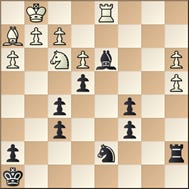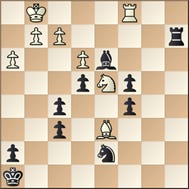The most important feature of the chess position is the activity of the pieces. This is absolutely fundamental in all phases of the game: opening, middlegame and especially endgame - Michael Stean
I've put a lot of weight on the merits of a good pawn structure in my writings on the endgame, but this month I'm going to show how piece coordination, initiative and the small matter of a dangerous passed pawn can all relegate such finely-drawn considerations to the sidelines.
GM Alexander Khalifman (2640) - IM Keith Arkell (2450)
London WFW (12), 1991
1.Nf3 Nf6 2.d4 e6 3.c4 Bb4+ 4.Nbd2 b6 5.a3 Bxd2+ 6.Bxd2 Bb7 7.Bf4 d6 8.e3
My opponent, world-ranked number 11 at the time and destined to be FIDE world champion a few years later, only needed to finish with two draws to win the tournament. However, I declined his peace offer around here, as I was looking for a strong finish after languishing in last place for much of the event.
8...Nbd7 9.Be2 Qe7 10.h3 Ne4 11.Bh2 f5 12.Rc1 a5 13.b3 0–0 14.0–0 e5
15.c5! In principle this is a nice idea, highlighting the exposed nature of my pawn structure.
15...bxc5 16.dxe5 dxe5 17.Bb5 c6
My position is just about OK here. It feels unpleasant because of the exposed pawns, but if I can coordinate my pieces there is actually quite a lot of central energy.
18.Bc4+ Kh8 19.Qe2 Nd6 20.Rfd1 Nxc4 21.Qxc4 Ba6
22.Qh4?! This move is not great. Khalifman wants to remove the defender of my sensitive points at e5, c5 and d7, but he also loses some control over his own weaknesses. Better would have been 22 Qc2 with a small edge.
22...Qxh4 23.Nxh4 Ra7
24.Rd6 With the knight sitting a little uneasily on h4, Alexander could have considered withdrawing it at once. However, after 24.Nf3 I was ready with 24...Be2 25.Rd6 Bxf3 to remove the pressure from e5. I could then continue 26...Kg8 with a view to over-protecting the knight, which is doing such a good job covering e5 and c5, and eventually put pressure on b3. Essentially my position is fine, however White plays.
24...e4 Some calculation will now be required as ...g5 is in the air, trapping the knight.
25.Rcd1 Bd3 This is both forced and a good move. My illustrious opponent has to tread a little carefully now, as the weak b-pawn is all there is to prevent my obtaining a strong passed pawn.
26.Nf3?
It seems natural to bring this awkward piece back into the fray, but White had to take the sting out of my next sequence with either 26.a4 or 26.Rxc6. For example, after 26.Rxc6 a4 27.b4! cxb4 he can rescue the situation with 28.Bd6!
26...a4! 27.bxa4 Rf6! 28.Rxf6 gxf6!
My structure doesn't look too pretty with two pairs of doubled isolated pawns, but this is entirely conceptual, and has no relevance to the assessment. White will have a terrible job coordinating his pieces to deal with my passed pawn, whereas mine are in perfect harmony.
29.Nd2 Rxa4 30.Bd6 My opponent's rook and knight can play some kind of a blockading role, but his bishop is struggling to participate.
30...Rxa3 31.Rc1 Ra2 32.Nb3 c4 33.Nd4 c5
34.Nxf5? 34.Nb5 was the last chance to hold up my c-pawn. After 34...Ra5 35.Nc3 I can use my king and rook to keep his bishop out of the game and eventually my knight should decide matters by manoeuvring to d5 and lifting the blockade.
34...Ra3 35.Nd4
35...Rb3! Cutting off the knight's retreat to c3 via b5.
36.Ne6 Rb6 37.Ra1 Kg8 38.Ra8+ Kf7 39.Nd8+ Kg6 40.Bc7 Rb1+ 41.Kh2
41...c3 With White's pieces tumbling over each other to find squares my initially weak pawn now can't believe its luck!
42.f4 exf3
0–1
Closing out with a hat-trick of victories vs GMs Hector, Khalifman and Suba, I managed to haul myself off the foot of the cross-table just in time!














